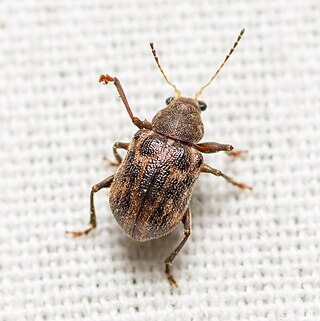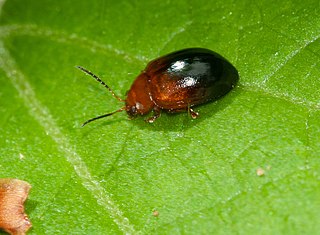
The insects of the beetle family Chrysomelidae are commonly known as leaf beetles, and include over 37,000 species in more than 2,500 genera, making up one of the largest and most commonly encountered of all beetle families. Numerous subfamilies are recognized, but the precise taxonomy and systematics are likely to change with ongoing research.

The Chrysomelinae are a subfamily of leaf beetles (Chrysomelidae), commonly known as broad-bodied leaf beetles or broad-shouldered leaf beetles. It includes some 3,000 species around the world.
Catherine N. Duckett is the Associate Dean of the School of Science at Monmouth University. Formerly she worked as Associate Director of the Office for the Promotion of Women in Science, Engineering and Mathematics, and the Program Manager of the Ocean Biogeographic Information System at Rutgers University, as well as a former Associate professor of Biology at University of Puerto Rico at Rio Piedras. She is also a prominent systematic entomologist, specializing in the phylogeny of flea beetles, and an adjunct professor at Rutgers.
Paleontology or palaeontology is the study of prehistoric life forms on Earth through the examination of plant and animal fossils. This includes the study of body fossils, tracks (ichnites), burrows, cast-off parts, fossilised feces (coprolites), palynomorphs and chemical residues. Because humans have encountered fossils for millennia, paleontology has a long history both before and after becoming formalized as a science. This article records significant discoveries and events related to paleontology that occurred or were published in the year 1878.

Xanthonia is a genus of leaf beetles in the subfamily Eumolpinae. It is distributed in North and Central America, and in East, Southeast and South Asia.
Nemognatha chrysomeloides is a species of oil beetle (Meloidae) endemic to Central and South America.

Smaragdina is a genus of short-horned leaf beetles belonging to the family Chrysomelidae, subfamily Cryptocephalinae.
Aulacophora abdominalis is a species of leaf beetle in the genus Aulacophora.

The Spilopyrinae are a small subfamily of the leaf beetles, or Chrysomelidae. They occur in Australia, New Guinea, New Caledonia and Chile. They were formerly considered a tribe of the subfamily Eumolpinae. The group was elevated to subfamily rank by C. A. M. Reid in 2000. However, some authors have criticised this placement, preferring to retain them within the Eumolpinae.

Calligrapha is a genus of large American Chrysomelinae of imprecise taxonomic boundaries. Most species occur in Central and South America.

Eumolpini is a tribe of leaf beetles in the subfamily Eumolpinae. It is the largest tribe in the subfamily, with approximately 170 genera found worldwide. Members of the tribe almost always have a longitudinal median groove on the pygidium, which possibly helps to keep the elytra locked at rest. They also generally have a subglabrous body, as well as appendiculate pretarsal claws.
Proneuronema is an extinct genus of lacewings in the neuropteran family Hemerobiidae known from fossils found in amber. The genus currently contains three species, P. gradatum and P. minor from Baltic amber and P. sidorchukae from Rovno amber. A Ypresian fossil from Washington state was initially also placed within the genus, having been moved from its original placement as Cretomerobius wehri, but was subsequently moved to the separate genus Archibaldia by Vladimir Makarkin (2023).

Rhyzobius chrysomeloides is a species of beetle in the family Coccinellidae. R. chrysomeloides is a predatory species, feeding on aphids. R. chrysomeloides can typically be found on various species of trees and garden shrubs, first being recorded in Britain in 1996 on a pine tree. R. chrysomeloides is visually similar to Rhyzoius litura, but can be differentiated by its broader prosternal keel and the darker, U-shaped markings on its elytra.
Tricholapita is a genus of leaf beetles in the subfamily Eumolpinae. The genus is endemic to New Caledonia.

Stictomela chrysomeloides, is a species of handsome fungus beetle found in Sri Lanka.
Theopea is a genus of skeletonizing leaf beetles in the family Chrysomelidae. There are more than 25 described species in Theopea. They are found in Indomalaya and the Palearctic. It is closely related to the genera Pseudotheopea and Borneotheopea.

Morphosphaera is a genus of skeletonizing leaf beetles in the family Chrysomelidae. There are about 11 described species in Morphosphaera. They are found in Indomalaya and eastern Asia.

Morphosphaera japonica is a species of skeletonizing leaf beetle in the family Chrysomelidae, found eastern Asia.

Morphosphaera sumatrana is a species of skeletonizing leaf beetle in the family Chrysomelidae, found in Malaysia and Indonesia.

Nisotra is a genus of flea beetles in the family Chrysomelidae. They are found in Africa, Asia, and Australia. There are around 90 described species in Nisotra, including about 70 in Sub-Saharan Africa and Madagascar. Many of these species are agricultural pests.













